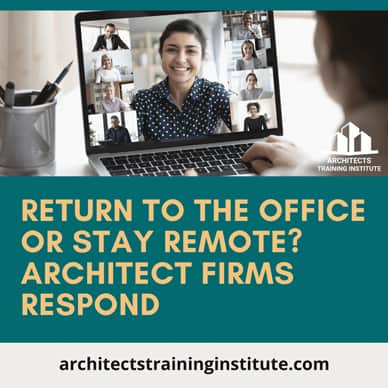Return to the Office Or Stay Remote? Architect Firms Respond
Published on September 14, 2021 by Nate Bortz

Despite the continued rollout of vaccines and many offices "re-opening," a lot of architecture firms are choosing to play the "wait and see" game.
In a recent Architectural Record article, architecture firms across the country reported that they're changing their fall office plans due to the COVID-19 variant surge. Here's an overview of that article, plus some potential benefits of hiring remote employees.
To Return, Or Not Return?
Here are some examples of how various nationwide architect firms have processed the decision to bring employees back to the office or not.
"Our plan in early summer was that, come September or October, we would ease back into working in the office," said Joe Tanney, the founder of Resolution: 4 Architecture, a small Manhattan firm. But now, thanks to the COVID-19 Delta variant, he said, "we're putting the brakes on that. The yellow lights are flashing." The firm is letting employees decide whether to stay home or come to the office. "We won't put any pressure on them," Tanney says.
This sentiment is a growing trend, according to Architectural Record. They say architects are thinking about when - and if - they will return to offices that have been vacant since early 2020. In addition, many architects say they wouldn't want to return to their old offices full-time even if they could.
A Miami-based firm Strang polled its 50 employees about returning to the office. 34% said they'd like to work from home full-time, while only 12% said they'd like to be at the office full-time. The majority chose various home/office splits. 84% said they are at least as productive working at home as working at the office.
The poll made founder Max Strang feel little pressure to reopen. Which is lucky, he says, since "the Delta variant derailed our initial plans to bring people back. Now, with Florida being a hotspot and many members of our team having young kids, we are letting people decide what's best for them for the time being."
But not all firm leaders are willing to let their architects go remote full-time. Thomas Bercy, of the Austin-based firm Bercy Chen Studio, was hoping his employees would be back by now. "But as COVID-19 cases started increasing again in Austin, we decided to remain flexible and allow remote work. That said, with our firm 100% vaccinated, we have decided to encourage returning to the office," Bercy said. Though working remotely was surprisingly effective during the pandemic, Bercy says, "Architecture is a creative profession. We feel that in-person interaction is critical to the sharing of ideas, drawings, and communication in general."
Potential Benefits of Remote Work
You may be on the fence about embracing full-time remote work or making your employees come back to the office, but according to this article from Architizer, fully remote employees can offer some serious benefits.
A Larger Labor Pool
According to Architizer, hiring permanently remote employees theoretically allows an architecture firm to hire staff from anywhere in the world, giving them access to the largest possible labor pool with the least amount of competitive restrictions.
While issues like local licensing requirements and the site visits during construction may prevent firms from hiring someone global to stamp drawings or supervise construction, positions focused on producing digital deliverables, like concept or early technical drawings, are ripe for fully remote designers.
Architizer argues that hiring permanently remote employees can remove economic obstacles that have typically prevented firms from taking advantage of a global talent pool, such as relocation or visa costs. Regardless of the ends being pursued, any firm hiring staff in distant locations should take a close look at their local labor regulations before doing so.
A Larger Project Pool
Complementing a remote labor pool is the prospect of more widespread project opportunities. Architizer says having remote employees expands the number of projects available for a firm to pursue and gives architects more options in the type of projects they want to take on.
However, Architizer warns that this practice is only viable under very specific conditions. Currently, just a small handful of architecture firms rely on a steady stream of global projects, Architizer says, typically brought in by a famous designer, then carried out only through conceptual or early technical phases while a second architect is hired to produce documents in line with local regulations.
Thus, the only way a relatively unknown firm could successfully pursue projects outside their region is if they can team up with a local firm to complete for much cheaper than that same local firm could do on its own.
As rare as this arrangement is right now, the recent expansion of remote working may open opportunities for small, young firms operating in low-cost areas or with fully remote staff to successfully pursue conceptual design work in high-cost areas.
Making successful teaming arrangements and building long-term relationships with a wide network of geographically dispersed architects would be a key concern for any designers interested in pursuing such a path.
Is your firm considering keeping employees remote? As expectations around office work continue to shift due to the pandemic, Architizer argues now is the perfect time for "forward-thinking designers" to start planning" for a remote-work dominated future.
